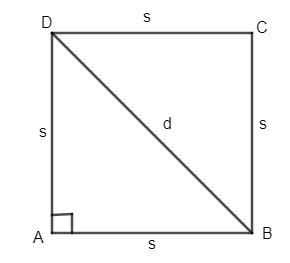
The area of a square field is \[156\dfrac{1}{4}{{m}^{2}}.\] What is the length of the diagonal of the square.
Answer
558.3k+ views
Hint: In this question, we need to find the length of the diagonal of the square whose area is \[156\dfrac{1}{4}{{m}^{2}}.\] For this we will first evaluate the side of the square using the formula of the area of the square which is given by \[\text{Area}=\text{side}\times \text{side}\text{.}\] Since all the angles of the square are 90 degrees, so the diagonal along with two sides will make a right angled triangle. Using the Pythagoras theorem in the right angled triangle will give us the length of the diagonal of the square. The Pythagoras theorem is given as \[{{\left( \text{Hypotenuse} \right)}^{2}}={{\left( \text{Base} \right)}^{2}}+{{\left( \text{Perpendicular} \right)}^{2}}.\]
Complete step-by-step answer:
Here, we are given a square of area \[156\dfrac{1}{4}{{m}^{2}}.\] Now, \[156\dfrac{1}{4}{{m}^{2}}\] can be written as \[156.25{{m}^{2}}.\] So, the area of the square is \[156.25{{m}^{2}}.\] We need to find the length of the diagonal of the square. So, let us first find the side of the square. Let us assume that the side of the square is s and the length of the diagonal is d. Our square will look like this.

Now, we know that the area of the square is given by
\[\text{Area}={{\left( \text{side} \right)}^{2}}\]
So, putting the values, we get,
\[\Rightarrow {{s}^{2}}=156.25\]
Taking the square root on both the sides, we get,
\[\Rightarrow s=\sqrt{156.25}\]
\[\Rightarrow s=12.5\]
Hence, the side of the square is 12.5m. Hence, AB = AD = CD = BC = 12.5m.
We need to find the length of BD. As we know that every angle of the square is 90 degrees, so angle A is 90 degrees. Hence, triangle ABD is a right angled triangle. By applying the Pythagoras theorem given by \[{{\left( \text{Hypotenuse} \right)}^{2}}={{\left( \text{Base} \right)}^{2}}+{{\left( \text{Perpendicular} \right)}^{2}}\] we get,
\[{{\left( BD \right)}^{2}}={{\left( AB \right)}^{2}}+{{\left( AD \right)}^{2}}\]
Since, AB = AD = 12.5m and BD = d, so,
\[{{d}^{2}}={{\left( 12.5 \right)}^{2}}+{{\left( 12.5 \right)}^{2}}\]
\[\Rightarrow {{d}^{2}}=156.25+156.25\]
\[\Rightarrow {{d}^{2}}=312.5\]
Taking the square root on both the sides, we get,
\[\Rightarrow d=\sqrt{312.5}\]
\[\Rightarrow d=17.677\]
Hence, the length of the diagonal of the square is 17.677m.
Note: Students should not forget to write the units for the found measurements. Since, both the diagonals of a square are of equal length, so we can evaluate any diagonal using any triangle. Take care while evaluating the squares and square roots of the numbers.
Complete step-by-step answer:
Here, we are given a square of area \[156\dfrac{1}{4}{{m}^{2}}.\] Now, \[156\dfrac{1}{4}{{m}^{2}}\] can be written as \[156.25{{m}^{2}}.\] So, the area of the square is \[156.25{{m}^{2}}.\] We need to find the length of the diagonal of the square. So, let us first find the side of the square. Let us assume that the side of the square is s and the length of the diagonal is d. Our square will look like this.

Now, we know that the area of the square is given by
\[\text{Area}={{\left( \text{side} \right)}^{2}}\]
So, putting the values, we get,
\[\Rightarrow {{s}^{2}}=156.25\]
Taking the square root on both the sides, we get,
\[\Rightarrow s=\sqrt{156.25}\]
\[\Rightarrow s=12.5\]
Hence, the side of the square is 12.5m. Hence, AB = AD = CD = BC = 12.5m.
We need to find the length of BD. As we know that every angle of the square is 90 degrees, so angle A is 90 degrees. Hence, triangle ABD is a right angled triangle. By applying the Pythagoras theorem given by \[{{\left( \text{Hypotenuse} \right)}^{2}}={{\left( \text{Base} \right)}^{2}}+{{\left( \text{Perpendicular} \right)}^{2}}\] we get,
\[{{\left( BD \right)}^{2}}={{\left( AB \right)}^{2}}+{{\left( AD \right)}^{2}}\]
Since, AB = AD = 12.5m and BD = d, so,
\[{{d}^{2}}={{\left( 12.5 \right)}^{2}}+{{\left( 12.5 \right)}^{2}}\]
\[\Rightarrow {{d}^{2}}=156.25+156.25\]
\[\Rightarrow {{d}^{2}}=312.5\]
Taking the square root on both the sides, we get,
\[\Rightarrow d=\sqrt{312.5}\]
\[\Rightarrow d=17.677\]
Hence, the length of the diagonal of the square is 17.677m.
Note: Students should not forget to write the units for the found measurements. Since, both the diagonals of a square are of equal length, so we can evaluate any diagonal using any triangle. Take care while evaluating the squares and square roots of the numbers.
Recently Updated Pages
Master Class 9 Social Science: Engaging Questions & Answers for Success

Master Class 9 Science: Engaging Questions & Answers for Success

Master Class 9 English: Engaging Questions & Answers for Success

Master Class 9 Maths: Engaging Questions & Answers for Success

Master Class 9 General Knowledge: Engaging Questions & Answers for Success

Class 9 Question and Answer - Your Ultimate Solutions Guide

Trending doubts
Which places in India experience sunrise first and class 9 social science CBSE

Fill the blanks with the suitable prepositions 1 The class 9 english CBSE

Write the 6 fundamental rights of India and explain in detail

Difference Between Plant Cell and Animal Cell

What is pollution? How many types of pollution? Define it

What is the Full Form of ISI and RAW




